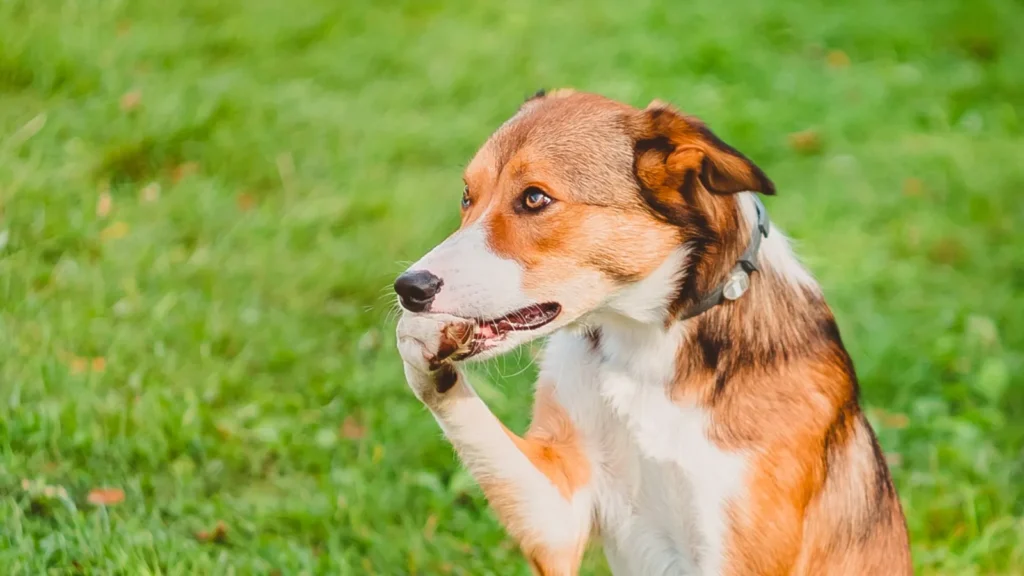As a responsible dog owner, it’s essential to recognize and address any unusual behavior exhibited by your furry friend. One common yet often overlooked issue is nail chewing, also known as onychophagia.
If you’ve caught your dog gnawing at his nails, you’re probably wondering why he’s doing it and what you can do to stop it. Nail chewing can be a sign of an underlying issue, and ignoring it can lead to more severe problems down the line.
In this article, we’ll delve into the reasons behind your dog’s nail chewing habit and provide you with practical advice on how to address it.
Why Is My Dog Chewing His Nails?
Possible Reasons for Nail Chewing
There are several reasons why your dog might be chewing on their nails. Here are some possible explanations:
- Anxiety and Stress: Dogs may chew on their nails due to anxiety or stress caused by changes in their environment, separation anxiety, or loud noises.
- Boredom: If your dog is not getting enough mental and physical stimulation, they might resort to nail chewing as a way to release pent-up energy.
- Pain or Discomfort: Your dog might be chewing on their nails due to pain or discomfort caused by arthritis, skin allergies, or nail problems.
- Medical Conditions: Certain medical conditions, such as hyperthyroidism, can cause excessive nail chewing in dogs.
- Habit: Some dogs may develop nail chewing as a habit, especially if they’re not provided with adequate chew toys or exercise.
Consequences of Nail Chewing
If left unchecked, nail chewing can lead to several consequences, including:
- Nail Damage: Excessive chewing can cause nail damage, leading to painful cracks, breaks, or infections.
- Paw Pad Irritation: Chewing on nails can cause irritation to the paw pads, leading to redness, swelling, and pain.
- Infections: Bacterial or fungal infections can occur if your dog ingests nail fragments or introduces bacteria into the nail bed.
- Dental Problems: Nail chewing can lead to dental problems, such as tooth wear, gum recession, or tooth loss.
How to Address Nail Chewing
To address nail chewing in your dog, follow these steps: (See Also: Does Neem Oil Kill Fleas On Dogs)
- Identify the Underlying Cause: Determine the reason behind your dog’s nail chewing behavior to address the root cause.
- Provide Adequate Exercise and Stimulation: Ensure your dog is getting enough physical and mental stimulation through exercise, play, and training.
- Offer Alternative Chew Options: Provide your dog with a variety of chew toys and treats to redirect their attention away from their nails.
- Trim Your Dog’s Nails Regularly: Keep your dog’s nails trimmed to reduce the temptation to chew on them.
- Consult a Professional: If your dog’s nail chewing persists, consult a veterinarian, animal behaviorist, or dog trainer for guidance and support.
Prevention and Maintenance
To prevent nail chewing and maintain your dog’s overall health, follow these tips:
- Regular Grooming: Regularly groom your dog to identify any potential nail problems early on.
- Nail Trimming: Trim your dog’s nails regularly to prevent overgrowth and reduce the temptation to chew.
- Healthy Diet: Feed your dog a balanced diet rich in nutrients to support their overall health and well-being.
- Regular Veterinary Check-Ups: Schedule regular veterinary check-ups to monitor your dog’s health and address any potential issues early on.
In conclusion, nail chewing in dogs can be caused by various factors, including anxiety, boredom, pain, medical conditions, and habit. It’s essential to identify the underlying reason and address it accordingly to prevent consequences such as nail damage, paw pad irritation, infections, and dental problems.
By providing adequate exercise and stimulation, offering alternative chew options, trimming your dog’s nails regularly, and consulting a professional when needed, you can help your dog overcome nail chewing behavior.
Remember to prioritize prevention and maintenance through regular grooming, nail trimming, a healthy diet, and regular veterinary check-ups.

Frequently Asked Questions
Why does my dog chew his nails excessively?
Excessive nail chewing in dogs can be caused by a variety of factors, including anxiety, boredom, or medical issues such as skin allergies or fleas. It’s essential to identify the underlying cause to address the behavior effectively.
Is nail chewing a sign of anxiety in dogs?
Yes, nail chewing can be a sign of anxiety in dogs. Dogs may engage in this behavior as a coping mechanism to release tension and stress.
If you suspect your dog’s nail chewing is related to anxiety, consult with a veterinarian or a certified animal behaviorist to develop a plan to address the underlying anxiety issues.
Can nail chewing cause health problems in dogs?
Yes, excessive nail chewing can lead to health problems in dogs, including skin irritation, infection, and painful paw pads.
Additionally, if your dog ingests the nails, it can cause gastrointestinal issues. It’s crucial to monitor your dog’s nail chewing behavior and take steps to prevent or address any potential health problems.
How can I prevent my dog from chewing his nails?
There are several ways to prevent nail chewing in dogs, including providing adequate exercise and mental stimulation, trimming your dog’s nails regularly, and using deterrents such as bitter-tasting nail sprays or bandages. You can also try redirecting your dog’s attention to a suitable chew toy or treat.
Should I take my dog to the vet if he’s chewing his nails?
Yes, it’s a good idea to take your dog to the vet if you notice excessive nail chewing. The veterinarian can rule out any underlying medical issues and provide guidance on how to address the behavior. Additionally, the vet can help you develop a plan to keep your dog’s nails trimmed and healthy.
